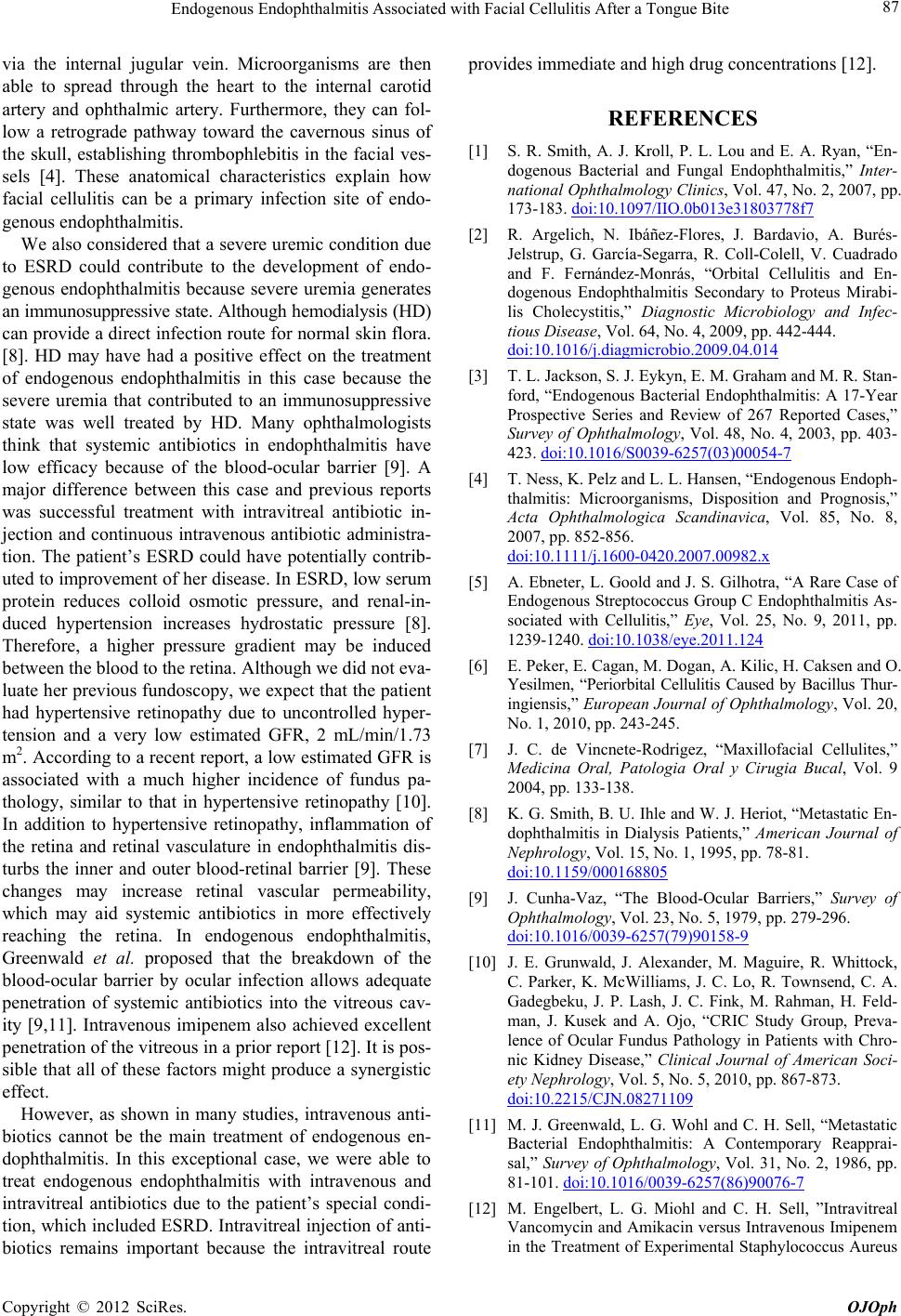
Endogenous Endophthalmitis Associated with Facial Cellulitis After a Tongue Bite 87
via the internal jugular vein. Microorganisms are then
able to spread through the heart to the internal carotid
artery and ophthalmic artery. Furthermore, they can fol-
low a retrograde pathway toward the cavernous sinus of
the skull, establishing thrombophlebitis in the facial ves-
sels [4]. These anatomical characteristics explain how
facial cellulitis can be a primary infection site of endo-
genous endophthalmitis.
We also considered that a severe ur emic condition due
to ESRD could contribute to the development of endo-
genous endophthalmitis because severe uremia generates
an immunosuppressive state. Although hemodialysis (HD)
can provide a direct infection route for normal skin flora.
[8]. HD may have had a positive effect on the treatment
of endogenous endophthalmitis in this case because the
severe uremia that contributed to an immunosuppressive
state was well treated by HD. Many ophthalmologists
think that systemic antibiotics in endophthalmitis have
low efficacy because of the blood-ocular barrier [9]. A
major difference between this case and previous reports
was successful treatment with intravitreal antibiotic in-
jection and continuous intravenous antibiotic administra-
tion. The patient’s ESRD could have potentially contrib-
uted to improvement of her disease. In ESRD, low serum
protein reduces colloid osmotic pressure, and renal-in-
duced hypertension increases hydrostatic pressure [8].
Therefore, a higher pressure gradient may be induced
between the blood to the retina. Although we did not eva-
luate her previou s fundoscopy, we expect that the patient
had hypertensive retinopathy due to uncontrolled hyper-
tension and a very low estimated GFR, 2 mL/min/1.73
m2. According to a recent report, a low estimated GFR is
associated with a much higher incidence of fundus pa-
thology, similar to that in hypertensive retinopathy [10].
In addition to hypertensive retinopathy, inflammation of
the retina and retinal vasculature in endophthalmitis dis-
turbs the inner and outer blood-retinal barrier [9]. These
changes may increase retinal vascular permeability,
which may aid systemic antibiotics in more effectively
reaching the retina. In endogenous endophthalmitis,
Greenwald et al. proposed that the breakdown of the
blood-ocular barrier by ocular infection allows adequate
penetration of systemic antibiotics into the vitreous cav-
ity [9,11]. Intravenous imipenem also achieved excellent
penetration of the vitreous in a prior report [12]. It is pos-
sible that all of these factors might produce a synergistic
effect.
However, as shown in many studies, intravenous anti-
biotics cannot be the main treatment of endogenous en-
dophthalmitis. In this exceptional case, we were able to
treat endogenous endophthalmitis with intravenous and
intravitreal antibiotics due to the patient’s special condi-
tion, which includ ed ESRD. Intravitreal injection of anti-
biotics remains important because the intravitreal route
provides immediate and high drug concentrations [12].
REFERENCES
[1] S. R. Smith, A. J. Kroll, P. L. Lou and E. A. Ryan, “En-
dogenous Bacterial and Fungal Endophthalmitis,” Inter-
national Ophthalmology Clinics, Vol. 47, No. 2, 2007, pp.
173-183. doi:10.1097/IIO.0b013e31803778f7
[2] R. Argelich, N. Ibáñez-Flores, J. Bardavio, A. Burés-
Jelstrup, G. García-Segarra, R. Coll-Colell, V. Cuadrado
and F. Fernández-Monrás, “Orbital Cellulitis and En-
dogenous Endophthalmitis Secondary to Proteus Mirabi-
lis Cholecystitis,” Diagnostic Microbiology and Infec-
tious Disease, Vol. 64, No. 4, 2009, pp. 442-444.
doi:10.1016/j.diagmicrobio.2009.04.014
[3] T. L. Jackson, S. J. Eykyn, E. M. Graham and M. R. Stan-
ford, “Endogenous Bacterial Endophthalmitis: A 17-Year
Prospective Series and Review of 267 Reported Cases,”
Survey of Ophthalmology, Vol. 48, No. 4, 2003, pp. 403-
423. doi:10.1016/S0039-6257(03)00054-7
[4] T. Ness, K. Pelz and L. L. Hansen, “Endogenous Endoph-
thalmitis: Microorganisms, Disposition and Prognosis,”
Acta Ophthalmologica Scandinavica, Vol. 85, No. 8,
2007, pp. 852-856.
doi:10.1111/j.1600-0420.2007.00982.x
[5] A. Ebneter, L. Goold and J. S. Gilhotra, “A Rare Case of
Endogenous Streptococcus Group C Endophthalmitis As-
sociated with Cellulitis,” Eye, Vol. 25, No. 9, 2011, pp.
1239-1240. doi:10.1038/eye.2011.124
[6] E. Peker, E. Cagan, M. Dogan, A. Kilic, H. Caksen and O.
Yesilmen, “Periorbital Cellulitis Caused by Bacillus Thur-
ingiensis,” European Journal of Ophthalmology, Vol . 20,
No. 1, 2010, pp. 243-245.
[7] J. C. de Vincnete-Rodrigez, “Maxillofacial Cellulites,”
Medicina Oral, Patologia Oral y Cirugia Bucal, Vol. 9
2004, pp. 133-138.
[8] K. G. Smith, B. U. Ihle and W. J. Heriot, “Metastatic En-
dophthalmitis in Dialysis Patients,” American Journal of
Nephrology, Vol. 15, No. 1, 1995, pp. 78-81.
doi:10.1159/000168805
[9] J. Cunha-Vaz, “The Blood-Ocular Barriers,” Survey of
Ophthalmology, Vol. 23, No. 5, 1979, pp. 279-296.
doi:10.1016/0039-6257(79)90158-9
[10] J. E. Grunwald, J. Alexander, M. Maguire, R. Whittock,
C. Parker, K. McWilliams, J. C. Lo, R. Townsend, C. A.
Gadegbeku, J. P. Lash, J. C. Fink, M. Rahman, H. Feld-
man, J. Kusek and A. Ojo, “CRIC Study Group, Preva-
lence of Ocular Fundus Pathology in Patients with Chro-
nic Kidney Disease,” Clinical Journal of American Soci-
ety Nephrology, Vol. 5, No. 5, 2010, pp. 867-873.
doi:10.2215/CJN.08271109
[11] M. J. Greenwald, L. G. Wohl and C. H. Sell, “Metastatic
Bacterial Endophthalmitis: A Contemporary Reapprai-
sal,” Survey of Ophthalmology, Vol. 31, No. 2, 1986, pp.
81-101. doi:10.1016/0039-6257(86)90076-7
[12] M. Engelbert, L. G. Miohl and C. H. Sell, ”Intravitreal
Vancomycin and Amikacin versus Intravenous Imipenem
in the Treatment of Experimental Staphylococcus Aureus
Copyright © 2012 SciRes. OJOph